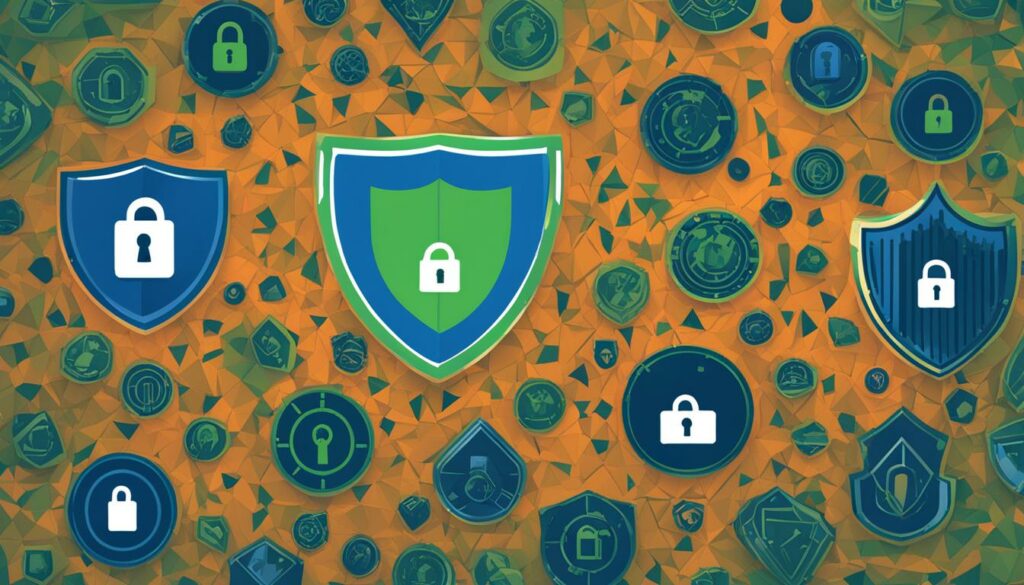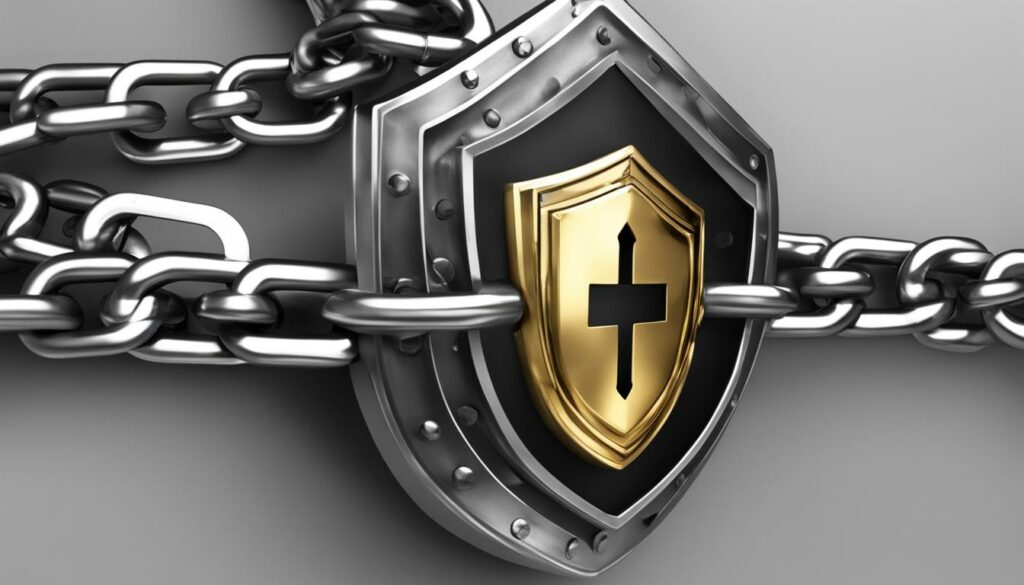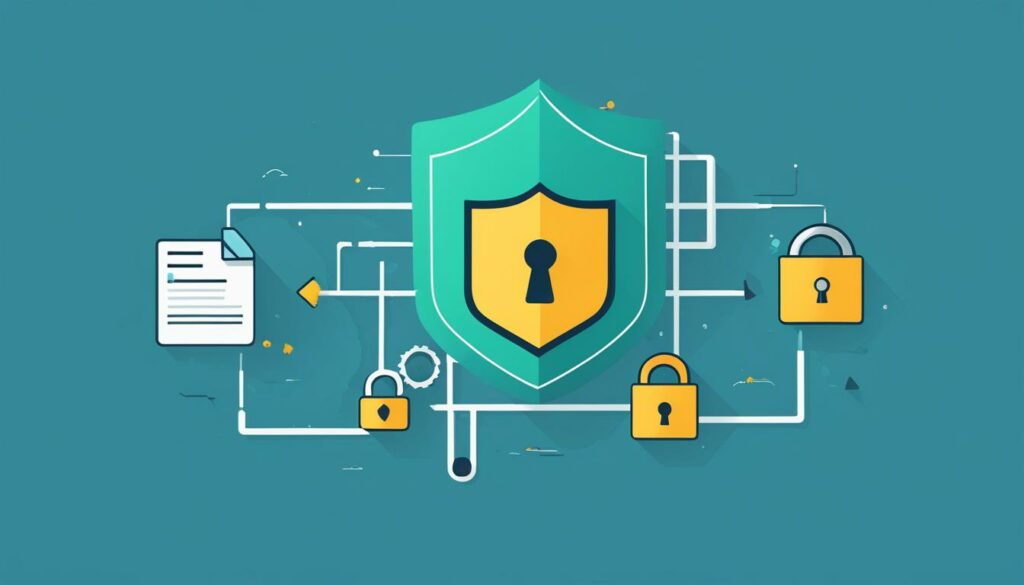Are you concerned about unauthorized users linking to your website’s content, consuming your bandwidth, and potentially stealing your images? Hotlinking can be detrimental to your website’s performance and security. In this article, we will explore effective strategies to prevent hotlinking and protect your valuable digital assets.
Hotlinking, also known as inline linking or image leeching, occurs when someone links to a file hosted on another website instead of hosting it on their own server. This act of linking to your content without permission not only violates your copyrights but can also result in increased hosting costs and slower page loading times.
To safeguard your content, there are various hotlinking prevention methods you can employ. These include:
- Using a Content Delivery Network (CDN) with built-in hotlink protection
- Adding code to your .htaccess file to block unauthorized referrers
- Disabling right-click functionality to deter hotlinking
- Adding watermarks to your images to discourage unauthorized use
- Renaming hotlinked files to break the links
- Issuing takedown requests to websites that hotlink your content
- Blocking IP addresses of repeat offenders
By implementing these strategies, you can prevent hotlinking, ensure your content is accessed only by authorized users, and protect your website’s performance and reputation. Don’t let others profit from your hard work and creativity.
Key Takeaways:
- Hotlinking is the act of linking to a file hosted on another website instead of hosting it yourself.
- Hotlinking protection helps safeguard your content and prevent unauthorized users from accessing it.
- Effective hotlinking prevention methods include using a CDN, adding code to your .htaccess file, disabling right-click functionality, adding watermarks to images, renaming hotlinked files, issuing takedown requests, and blocking IP addresses.
- Preventing hotlinking can save bandwidth, improve website performance, and protect your copyrights.
- BoostedHost offers reliable WordPress Hosting for optimal performance and hotlink protection. Sign up now through this link.
What is Hotlinking?
Hotlinking is the practice of linking to a file hosted on another website instead of hosting it on your own server. It most commonly occurs with images but can also happen with other types of files. Hotlinking is considered bad etiquette as it consumes the bandwidth of the website hosting the file without benefiting them. Some people consider hotlinking to be a form of theft.
Hotlinking is like using someone else’s resources for your benefit without their permission. It’s not only unethical but can also lead to increased costs for the website owner and result in slow loading times for visitors.
When someone hotlinks to an image on your website, it means that they are displaying the image on their own website by directly linking to the URL of the image on your server. This means that every time someone accesses their website and the image is displayed, it’s being loaded from your server. As a result, the website hosting the image has to bear the bandwidth costs and server resources required to serve the image.
Why is Hotlinking a Problem?
- Bandwidth Theft: Hotlinking consumes the bandwidth of the website hosting the file, potentially leading to higher hosting costs for the website owner.
- Social and Search Traffic Loss: If your content is hotlinked, people viewing the content on other websites may not be aware of your website as the original source. This can lead to a loss of social media shares, backlinks, and referral traffic.
- Slow Loading Times: When multiple websites hotlink the same image, it can impact the loading speed of your website, resulting in a poor user experience.
By understanding the concept of hotlinking and its negative implications, you can take steps to protect your content and ensure that only authorized users can access it.
What is Hotlinking Protection?
Hotlinking protection is an essential practice for safeguarding your website’s content and ensuring that only authorized users have access to it. Hotlinking, or the act of using images or files hosted on another website instead of your own, can have detrimental effects on your website’s performance and cost you valuable resources.
By implementing hotlinking protection measures, you can enjoy a host of benefits that will enhance your website’s overall security and performance. Key advantages include:
- Bandwidth savings: Hotlinking can consume a significant amount of your bandwidth, resulting in higher costs from your hosting provider. By protecting your content from hotlinking, you can save bandwidth for legitimate users and reduce your hosting expenses.
- Improved website speed and performance: Hotlinking can slow down your website’s loading times, causing a frustrating user experience. Hotlinking protection helps mitigate this issue by preventing unauthorized requests for your files, resulting in faster page load times and a more positive user experience.
- Preserved website integrity: Hotlinking to your website’s content without permission can damage your brand’s reputation and can associate you with less reputable sites. Protecting your content ensures that your website remains secure and respected by visitors and other online platforms.
| Benefits of Hotlink Protection | Importance of Hotlink Protection |
|---|---|
| 1. Bandwidth savings | 1. Preserved website integrity |
| 2. Improved website speed and performance | 2. Reduced risk of copyright infringement |
| 3. Protection against unauthorized resource usage | 3. Enhanced user experience |
The effectiveness of hotlinking protection relies on implementing the right strategies and tools. Some popular methods include:
- Using a Content Delivery Network (CDN) with built-in hotlink protection.
- Adding code to your website’s .htaccess file to restrict unauthorized access to your files.
- Disabling right-click functionality to discourage users from easily copying and hotlinking your images.
- Adding visible watermarks to your images, making them less desirable for unauthorized use.
- Issuing takedown requests to websites that hotlink your content without permission.
- Blocking IP addresses of repeat offenders to prevent further unauthorized access.
Investing in hotlinking protection measures not only safeguards your content but also guarantees an improved website experience for your users. Protect your digital assets, save bandwidth, and maintain the integrity of your website by implementing effective hotlink protection today.

How to Prevent Hotlinking
To protect your website from hotlinking, there are several effective prevention methods and strategies you can employ. By implementing these measures, you can safeguard your content, preserve your website’s bandwidth, and maintain control over your digital assets. Here are some tips to prevent hotlinking:
- Utilize a CDN with Built-in Hotlink Protection: Content Delivery Networks (CDNs) offer hotlink protection features that can automatically block unauthorized requests for your files. This ensures that only authorized users can access and display your content. Consider choosing a reputable CDN provider with robust hotlinking prevention capabilities.
- Add Code to Your .htaccess File: Modify your website’s .htaccess file to block unauthorized referrers from linking to your files. This prevents hotlinking by restricting access to your content based on the source of the request.
- Disable Right-Click Functionality: Disabling the right-click functionality on your website can discourage hotlinking. This prevents users from easily downloading and copying your images or other content, making it less tempting for unauthorized parties.
- Add Watermarks to Your Images: By adding visible watermarks to your images, you discourage unauthorized use and increase your content’s traceability. This extra layer of protection acts as a deterrent for hotlinkers, as they will be less likely to use watermarked images on their websites.
- Rename Hotlinked Files: Renaming the filenames of your hotlinked files can effectively break the links to your content. Hotlinkers typically link directly to the filenames, so by renaming them, you invalidate those links and prevent the unauthorized display of your content.
- Issue Takedown Requests: Monitor the internet for websites that hotlink your content without permission. If you come across such websites, send them a formal takedown request, asking them to remove your content immediately. Most websites have a designated contact or DMCA page where you can submit these requests.
- Block IP Addresses of Repeat Offenders: If you notice specific IP addresses repeatedly hotlinking your content, you can block those addresses from accessing your website. This can be done through your website’s server or using security plugins, effectively preventing further hotlinking attempts from those sources.
Implementing these hotlinking prevention methods and strategies will go a long way in ensuring that your website’s content remains protected and accessible only to authorized users.

What is Image Hotlinking?
Image hotlinking refers to the practice of linking to images hosted on another website instead of hosting them on your own server. This means that when someone visits your website and sees an image, it is actually being loaded from another website’s server. This can have several negative consequences for your website, including:
- Increased bandwidth usage: When visitors load images from another website, it consumes your server’s resources and bandwidth.
- Slower page loading speed: As images are loaded from an external server, it can slow down the loading speed of your website.
- Higher server resource consumption: Image hotlinking can put a strain on your server’s resources, leading to slower performance.
Image hotlinking without permission is considered unethical and can cause financial and reputational harm to the website owner. By hotlinking to someone else’s images, you are essentially using their resources without their consent or knowledge.
To better understand image hotlinking, consider this example:
You have a photography blog and spend hours capturing and editing stunning images. One day, you notice that a popular website in your niche is using your images without your permission. Instead of downloading and hosting the images on their own server, they simply hotlink to the images on your website. This not only consumes your bandwidth but also deprives you of credit and potential traffic to your blog.
Preventing image hotlinking is essential to protect your content, preserve your server resources, and maintain your brand’s reputation. In the next section, we will discuss strategies to prevent image hotlinking and safeguard your digital assets.
How to Prevent Image Hotlinking
Preventing image hotlinking is crucial for safeguarding your website’s content and preserving your bandwidth. By implementing effective hotlink protection methods, you can ensure that only authorized users have access to your valuable images. Here are some strategies to prevent image hotlinking:
- Utilize a CDN with Hotlink Protection: Content Delivery Networks (CDNs) offer built-in hotlink protection features that prevent unauthorized websites from hotlinking your images. This method ensures that your images are only displayed on your own website.
- Add Code to Your .htaccess File: By adding specific code snippets to your .htaccess file, you can restrict referrers and block hotlinking attempts. This prevents external websites from linking to your images without permission.
- Use Hotlink Protection Plugins: If you’re using WordPress, there are several plugins available that are designed to protect your images from hotlinking. These plugins provide easy-to-use settings and configurations to prevent unauthorized access to your image files.
- Utilize cPanel’s Hotlink Protection Features: Many web hosting providers offer hotlink protection features within their cPanel control panel. These features allow you to block hotlinking attempts and specify which websites are allowed to display your images.
- Disable Right-Click Functionality: Disabling right-click functionality on your website can deter users from easily saving and hotlinking your images. Although this method is not foolproof, it adds an extra layer of protection.
- Rename Image Files: By renaming your image files periodically, you can break any existing hotlinks. This method requires updating the image URLs on your website, but it can effectively deter hotlinking.
Implementing these image hotlink protection methods will help safeguard your content, preserve your bandwidth, and maintain control over your valuable images.

Note: The image above illustrates the importance of preventing image hotlinking.
Why Hotlinking is Bad for Your Website
Hotlinking can have several negative effects on your website. It can lead to increased server resource usage, slower page loading times, higher hosting costs, and potential copyright infringement. Bandwidth theft through hotlinking can put a strain on your server and impact the overall performance of your website. Additionally, hotlinking without permission is considered unethical and can damage your brand’s reputation.
Consequences of Hotlinking
- Increased server resource usage
- Slower page loading times
- Higher hosting costs
- Potential copyright infringement
“Hotlinking is like eating someone else’s food without permission. It depletes their resources and leaves them with nothing while you enjoy the feast.”
When other websites hotlink to your content, they consume your bandwidth without your consent. This can slow down your site and make it inaccessible for genuine visitors. The more visitors your website attracts, the greater the strain on your server, leading to decreased performance and user satisfaction. Moreover, hotlinking can result in higher hosting costs as you may exceed your allocated bandwidth limits.
In addition to the negative impact on server performance and costs, hotlinking can also lead to potential copyright infringement. By hotlinking to your content, other websites may be using it without permission, violating your intellectual property rights. This can undermine your credibility as a content creator and harm your brand’s reputation.
To protect your website from the negative effects of hotlinking, it is important to implement hotlinking prevention measures. By doing so, you can preserve your server resources, ensure optimal website performance, and safeguard your valuable content from unauthorized use.

| Effect of Hotlinking | Consequence |
|---|---|
| Increased server resource usage | Strain on server performance |
| Slower page loading times | Poor user experience |
| Higher hosting costs | Exceeding bandwidth limits |
| Potential copyright infringement | Harm to brand reputation |
Does Blocking Hotlinking Hurt Your SEO?
When it comes to the impact of hotlinking on your SEO, the good news is that blocking hotlinking does not directly hurt your search engine optimization efforts. However, it is crucial to implement hotlink protection correctly to ensure that search engine crawlers can still access and index your valuable content.
Hotlink protection features offered by CDNs, plugins, and server configurations should be carefully set up to avoid interfering with search engine crawling. This ensures that your website’s pages, including images, are properly indexed, which can positively impact your organic search rankings.
It’s important to note that blocking hotlinking does not affect how search engines perceive or rank your website directly. The primary purpose of hotlink protection is to prevent unauthorized users from using your bandwidth and potentially stealing your content. By blocking hotlinking, you preserve your server resources, prevent slow loading times, and protect your website’s content from copyright infringement.
However, it’s worth considering the potential impact on Google image search traffic. Google image search can be a valuable source of organic traffic for websites with image-rich content. When blocking hotlinking, you need to ensure that Google’s image crawler can still access and index your images to appear in relevant search results.
To strike a balance between hotlink protection and SEO, you can:
- Configure your hotlink protection settings to allow search engine crawlers access to your content while blocking unauthorized users.
- Set up proper alt tags for your images to provide context to search engines and improve the likelihood of appearing in relevant image search results.
- Submit an XML sitemap to ensure that search engines can discover and crawl all your website’s pages, including protected content.
By following these best practices, you can effectively block hotlinking, protect your content, and maintain a strong presence in search engine results. Remember, while preventing hotlinking itself may not directly improve your SEO, it helps safeguard your website’s performance and reputation, which indirectly benefits your search rankings.
| Pros of Blocking Hotlinking on SEO | Cons of Blocking Hotlinking on SEO |
|---|---|
| – Preserves server resources | – Potential impact on Google image search traffic |
| – Prevents slow page loading times | |
| – Protects content from unauthorized use and copyright infringement | |
| – Improves website’s performance and user experience |
How to File a DMCA Takedown Notice
If your content is being hotlinked without permission, you can take action by filing a DMCA takedown notice. This notice is a powerful tool in combating copyright infringement and protecting your intellectual property.
The DMCA, or Digital Millennium Copyright Act, provides a legal framework for addressing copyright violations on the Internet. It gives content creators the ability to request the removal of infringing material from websites.
When filing a DMCA takedown notice, you must provide the following information:
- A description of the copyrighted work that is being infringed. This can include text, images, videos, or any other creative work that you own.
- The location of the infringing material. This can be a URL or specific webpage where the copyrighted content is being used without authorization.
- Contact information, including your name, address, phone number, and email address.
- A statement that you have a good faith belief that the use of the copyrighted material is not authorized by the copyright owner, its agent, or the law.
- A statement that the information in the notification is accurate, and under penalty of perjury, that you are the copyright owner or are authorized to act on behalf of the owner.
- Your electronic or physical signature.
Once you have prepared the DMCA takedown notice, you can send it to the website owner or their hosting provider. In many cases, websites have a designated email address or online form for submitting copyright infringement notices.
It’s important to note that filing a DMCA takedown notice is a serious matter, and false claims could lead to legal consequences. Therefore, ensure that you have valid evidence of copyright ownership before proceeding with the process.
Taking action against copyright infringement not only protects your creative work but also helps to combat the widespread problem of intellectual property theft. By asserting your rights through the DMCA takedown process, you contribute to a safer and more respectful online environment.
Image illustrates the process of filing a DMCA takedown notice to combat copyright infringement.
Conclusion
Protecting your content and implementing hotlinking prevention strategies are crucial for safeguarding your digital assets. Hotlinking, if left unchecked, can result in increased server costs, slower page loading times, and potential copyright infringement. To ensure the security and integrity of your website, consider the following strategies:
- Use a CDN with hotlink protection: CDNs (Content Delivery Networks) offer built-in hotlink protection features that can help prevent unauthorized access to your content.
- Add code to your .htaccess file: By adding specific code to your .htaccess file, you can block unauthorized referrers and prevent hotlinking.
- Disable right-click functionality: Disabling right-click functionality can discourage users from easily downloading or hotlinking your images.
- Issue takedown requests: If you come across websites that are hotlinking your content, you can issue takedown requests to have the unauthorized material removed.
By employing these hotlink protection strategies, you can effectively safeguard your valuable content, preserve your bandwidth, and maintain the integrity of your website. Remember, protecting your digital assets should be a proactive effort to ensure that only authorized users have access to your content.
BoostedHost: Your Reliable WordPress Hosting Provider
For optimal performance and enhanced website security, we recommend WordPress Hosting from BoostedHost. Their reliable hosting solutions are designed to provide top-notch performance and hotlinking prevention.
Sign up now through this link: www.boostedhost.com/wordpress-hosting and ensure the protection of your content and digital assets.
Conclusion
Hotlinking can have negative consequences for your website’s performance and security. It not only increases server costs and slows down page loading times but also puts your valuable content at risk of copyright infringement. To protect your digital assets and safeguard your website, it is crucial to implement hotlink prevention strategies.
One effective method is to use a Content Delivery Network (CDN) with built-in hotlink protection. A CDN distributes your content across multiple servers globally, ensuring faster load times and reducing the risk of hotlinking. Additionally, you can add code to your .htaccess file to block unauthorized referrers, preventing hotlinked files from displaying on other websites.
Disabling right-click functionality and adding watermarks to your images are simple yet effective ways to discourage unauthorized use and protect your visual content. Furthermore, issuing takedown requests to websites that hotlink your content can help ensure that your digital assets are used only with your permission.
By proactively implementing these hotlinking prevention strategies, you can effectively protect your content, preserve your bandwidth, and maintain the integrity of your website. Remember, safeguarding your digital assets is essential to maintaining a secure online presence. So take action today to prevent hotlinking and safeguard your valuable content.
FAQ
Q: What is hotlinking?
A: Hotlinking is the act of linking to a file hosted on another website instead of hosting it yourself. It is considered bad etiquette and can lead to increased website hosting costs.
Q: What is hotlinking protection?
A: Hotlinking protection is a practice that helps safeguard your content and prevent unauthorized users from accessing it. It can save bandwidth, improve website speed and performance, and avoid association with less reputable sites that may be hotlinking to your content.
Q: How can I prevent hotlinking?
A: There are several methods you can use to prevent hotlinking, such as using a CDN with hotlink protection, adding code to your .htaccess file, disabling right-click functionality, adding watermarks to your images, renaming hotlinked files, issuing takedown requests, and blocking IP addresses.
Q: What is image hotlinking?
A: Image hotlinking specifically refers to the practice of linking to images hosted on another website instead of hosting them on your own server. This can lead to increased bandwidth usage, slower page loading speed, and higher server resource consumption.
Q: How can I prevent image hotlinking?
A: To prevent image hotlinking, you can use hotlink prevention tools or code snippets. Some popular methods include utilizing a CDN with hotlink protection, adding code to your .htaccess file to restrict referrers, using plugins designed for hotlink protection in WordPress, and utilizing hotlink protection features in cPanel.
Q: What are the negative effects of hotlinking?
A: Hotlinking can have several negative effects on your website, including increased server resource usage, slower page loading times, higher hosting costs, and potential copyright infringement.
Q: Does blocking hotlinking hurt my SEO?
A: Blocking hotlinking does not directly hurt your SEO. However, it is important to set up hotlink protection correctly to ensure that search engine crawlers can still access and index your content.
Q: How can I file a DMCA takedown notice?
A: If your content is being hotlinked without permission, you can file a DMCA takedown notice to request the removal of the infringing material. This notice informs the website owner or hosting provider that they are using copyrighted content without authorization.
If the infringer fails to comply, legal action can be pursued.
Q: Why should I protect my content from hotlinking?
A: Hotlinking can have negative consequences for your website, including increased server costs, slower page loading times, and potential copyright infringement. By implementing hotlink protection measures, you can safeguard your content and preserve your bandwidth.
Q: How can I protect my content from hotlinking?
A: To protect your content from hotlinking, you can utilize hotlink prevention methods such as using a CDN, adding code to your .htaccess file, disabling right-click functionality, and issuing takedown requests.












